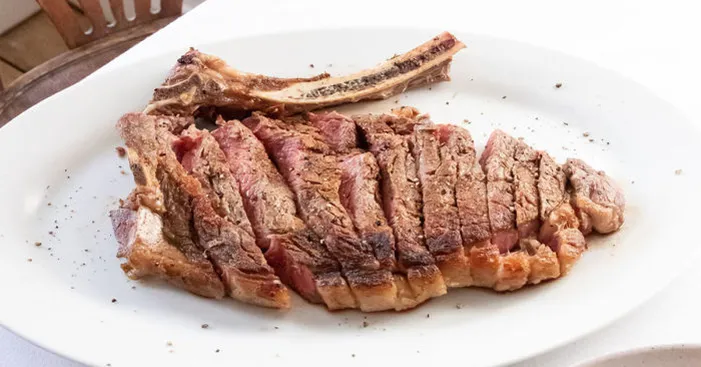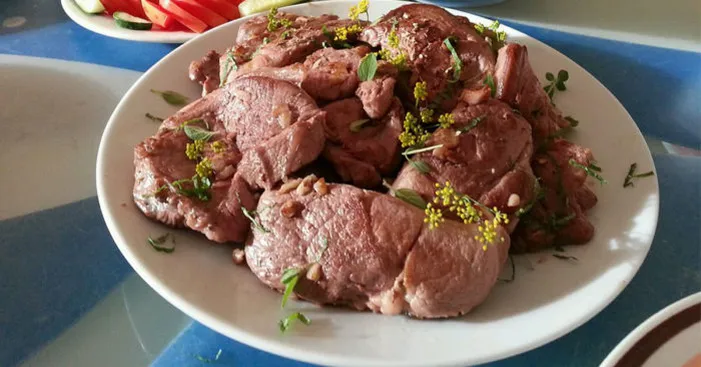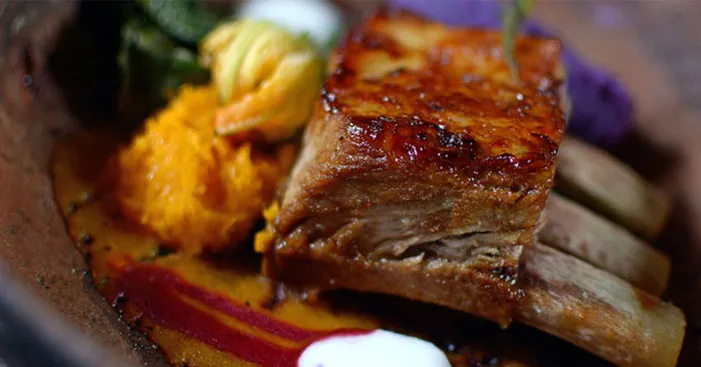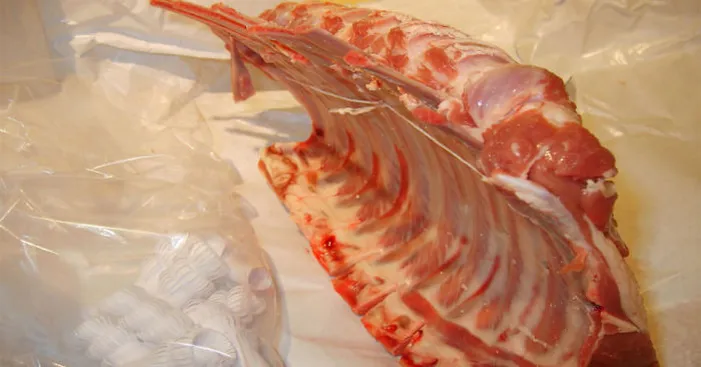Table of Contents

Lamb calories differ from a cut to other as some parts contain more fats than the others.
Even though we don’t consume lamb that often, there are some very beneficial nutrients in this red meat and we should definitely consider eating it.
In this article, we provide you with all the nutritional data of lamb meat based on trusted resources (USDA), lamb calories per cut, alongside useful tips on how to buy,cook and store lamb.
Lamb calories:
The daily recommended lamb meat is 70g (2.5ounces) and that contains: (1)

- Calories: 156.5
- Protein: 23 g
- Fat: 6.6 g
- Cholesterol: 75.6 mg (25.5% DI)
- B9 vitamin: 12.6%
- B12 vitamin: 34.3%
- D vitamin: 0.6%
- Calcium: 2.3%
- Iron: 7.6 %
- Magnesium: 4.38%
- Phosphorus: 18.3%
- Potassium: 6.4%
- Zinc: 26%
Lamb calories vary depending on the parts for example ribs provide 232 cal/3.5oz (100g) but for the same size thighs only offer 128cal.
Fats:
Also, the fat content varies for the same amount of 3.5oz (100g) ribs offer 18g of fat whilst thighs offer 6g.
The leanest cuts of a lamb are from the thighs and the fattest are usually from the shoulders and breast. (2)
As for the composition of fat in lamb, it almost follows a 50/50 rule between saturated and unsaturated fats.
Furthermore, lamb calories contain a very low amount of Trans fatty acids 0.1g per serving which is almost zero as the American heart association recommends.
Protein:
Lamb also offers a good amount of protein with an average of 16g which is less than chicken or beef.
However, it is a source of complete protein with all of the 9 essential amino acids which helps meet the daily goal. (3)
Minerals:
Lamb calories are also a good source of phosphorus with 15% of the daily need in each 2.5oz (70g).
By eating lamb, you’ll help your body reach its daily need of phosphorus which helps maintain bones, teeth, and cells composition.
Another mineral that lamb calories contain is zinc with 20% of the daily need per serving (2.5oz, 70g).
Zinc is a necessary element particularly for the process of cells creation as it is one of the main components. (4)
Also, lamb calories offer Iron with 7% of the daily need per each 70g (2.5oz).
By consuming lamb and meeting the daily need in Iron you will have a very low risk of getting anemia.
You should also know that lamb iron is 70% heme iron which is the easiest in terms of absorption by the body. (5)
Vitamins:
On the other hand, lamb calories provide a good amount of vitamin B12 with up to 35% per serving (2.5oz, 70g).
This vitamin is essential for the production of red blood cells which makes it beneficial in case of anemia. (6)
In addition, lamb calories have 25% of our daily need in vitamin B3 (niacin) per 70g (2.5oz).
Our bodies need vitamin B3 to get the most nutrients from the food we eat and transform it into energy.
Lamb calories per cut:

Lamb neck (collar):
The meat on the neck of a lamb is very tasteful as it is mostly made of muscles as the animal has to move its head searching for food. (7)
This part of lamb is the richest in vitamin B12 (100% of the daily need per serving).
Shoulders:
This is one of the parts that contain the most fats and is poor in terms of nutrients compared to other cuts.
It has the highest calorie intake with up to 200 calories per 2.5oz (70g).
Even though it contains the least amount of nutrients it still offers a good boost of phosphorus, zinc, iron, and vitamins. (8)
Ribs:
Second only to lamb neck, the ribs offer about 50% of the daily need in vitamin b12 per serving.
By eating lamb ribs you help your body reach its need in B12 and avoid digestion problems, weight disorder, and anemia. (9)
Breasts:
Lamb’s breast is also rich in fat with a lot of bones and a low meat-to-bones ratio.
However, this part of lamb is the richest in vitamin B2 and B1 respectively with 20 and 12% of the daily need per serving.
Lamb’s legs:
This is the part of the lamb that is on the lower part of the leg almost the same as a chicken drumstick.
It is among the leanest cut of lamb with just 155 calories per 2.5oz (70g).
It offers all the 9 essential amino acids and it is particularly rich in vitamin b12.
Lamb fillets:
This part of lamb is taken from the lumbar part of the animal between the ribs and the legs.
There are two different lamb types: (10)
- Two fillets come from the external loins.
- Two fillets of “mignon”, more tender and come from two stripes of meat located under the loins.
An average lamb fillet usually offers the leanest lamb cut with just 85 calories per serving (2.5oz, 70g).
Cooking tips to preserve nutrients in lamb calories:
Common mistakes:

Choosing boneless cuts:
You may think that the parts of lamb with no bones are easier to cook which is not the case.
In fact, the parts of meat close that are attached to the bones are softer and tenderer.
On the contrary, the parts that don’t have bones are stiffer and less juicy.
Cooking frozen lamb:
Generally, regardless of the type of meat, it is not a good idea to cook it immediately after taking it out of the fridge.
This is because the meat won’t have the same temperature on the surface and inside of it and this will cause it to be cooked unevenly.
You should take meat, whether it’s lamb or any type, out from the fridge 2 hours before cooking until it reaches room temperature.
Not preparing lamb the right way:
Lamb is among the tough meat same as beef, therefore it needs a proper softening before cooking.
To soften lamb meat you can put it in a brine solution for 2 hours before cooking. (11)
To make an easy brine solution:
- Boil some water with garlic, salt, parsley, rosemary, and any seasoning herb of your choice.
- Take the mixture off the heat and let it cool.
- Submerge your lamb pieces in the solution and leave them for 1 to 2 hours before you use them in your recipe.
Wrong use of seasoning:
Natural seasoning like garlic and rosemary are better than grounded spices, especially for grilling. (12)
This is because grounded spices like cumin or paprika tend to burn easily when you grill the meat which affects the taste of the meat.
Not letting lamb meat rest after cooking:
Even though cutting hot pieces of meat is easier, it is wrong to cut lamb meat immediately after cooking.
It is best to let cooked lamb rest for 20 minutes after cooking to ensure that the juices are spread evenly in the meat.
Overcooking:
The more you cook lamb the more nutrients it loses and the tougher it gets. (13)
Scientifically, red meat fibers contain water and tendons which turn into gelatin during cooking which gives the meat its juiciness.
When you overcook lamb the water in that gelatin composition starts to evaporate and result in a slice of dry and chewy meat.
A healthy lamb recipe:
Lamb with garlic and onion:

In most of the Arabian countries and other countries in Asia and America, people use lamb meat in their traditional dishes.
This is a delicious dish that you can find in many restaurants all around the world and it is so easy to make.
Here’s how to make it:
Ingredients:
- 2 pieces of lamb (1lbs or 500g).
- 6 small onions or 4 average ones.
- 2 chopped garlic.
- 1tbsp of chopped parsley.
- 1 tbsp of apple vinegar.
- ½ tbsp. of sugar.
- 1tsp of salt and 1 tsp of ground black pepper.
- 2 tbsp of olive oil.
Preparation:
- Cut the lamb into small pieces and keep them as thick as possible.
- In a bowl, marinate the pieces of meat in apple vinegar along with garlic, salt, ground black pepper, and sugar.
- Let them rest for 4 minutes and in the meantime heat olive oil in a frying pan and start frying the onion until it’s done.
- Pour the fried onion with its oil on the meat pieces and mix all the ingredients together.
- Get an oven tray and cover its surface with baking paper then place your seasoned lamb pieces into the tray.
- Stick the tray in the oven and let it cook for 20 minutes at 300°F (150°C).
- Take your lamb pieces out of the oven and serve them with parsley on top for decoration.
Buying lamb:

Unlike other red meats, lamb quality is not determined by its color. (14)
Good lamb meat should be tight with white fat and these two are good signs of freshness.
Most of the lamb meat in the market comes from heavy sheep and tastes fattier and more pronounced.
Nonetheless, the younger the sheep the tender it is and the less-pronounced it tastes.
Regardless of the age of the animal, its weight is usually 65% bones and 35% meat.
Some parts may contain more bones than the others, for example, a lamb leg offers about 13 to 15% of meat.
However, a whole lamb leg usually weighs about 5lbs (2.25kg) and yields about 12oz (330g) of meat enough to feed 5 people.
A good lamb chop should weigh about 170g (6oz) and is a proper serving for one person as half of the weight comes from bones.
When you buy lamb meat you will mostly have a little fat on it which you can trim, however, make sure you leave some for cooking.
Also, make sure you don’t cut lamb meat thin as its thickness allows it to remain soft and tasty after cooking.
Storing lamb meat:

- If you are buying fresh lamb meat you may keep it for up to 3 days in the refrigerator. (15)
- You can also freeze lamb meat for 10 months and it will keep all its calories and nutrients.
- Ground lamb meat contains some additives and because of that, it is best eaten the same day of purchase.
- However, you can also freeze ground lamb meat for 10 months just make sure you eat it the same day it thaws.
- As for cooked lamb meat, whether in a stew or grilled, you can refrigerate it for 5 days or freeze it for 2 to 3 months.
- The freezing lifespan of cooked lamb depends entirely on the sauce composition and the cooking method.
References:
(1): FoodData Central (usda.gov)
(2): How to choose the right cut of lamb | Features | Jamie Oliver
(3): Surprising facts about lamb! Why the nutrients from lamb create such a healthy body | The Meat Guy Japan
(4): Role of Zinc in Growth and Cell Proliferation | The Journal of Nutrition | Oxford Academic (oup.com)
(5): Biochemistry, Iron Absorption – StatPearls – NCBI Bookshelf (nih.gov)
(6): Vitamin B12 Deficiency Anemia | Michigan Medicine (uofmhealth.org)
(7): Lamb neck | Jim Drohman
(8): Lamb 101: Nutrition Facts and Health Effects (healthline.com)
(9): Why B12 is so important — BEEF + LAMB NEW ZEALAND (beeflambnz.co.nz)
(10): FILLET (recipes.co.nz)
(11): How to Brine Lamb (leaf.tv)
(12): Which herbs go with lamb (and how to grow them) | The Neff Kitchen
(13): Does Lamb get more tender the longer you cook it? (antonscafebar.com)
(14): Tips for Buying the Best Lamb | HuffPost Life
(15): storing lamb – Google Search
